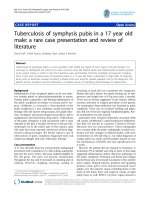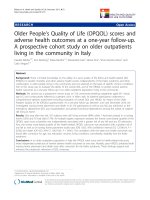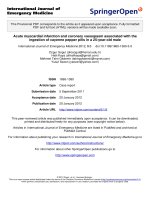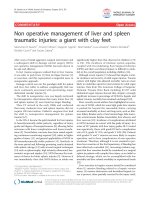Management of bumble foot in duck
Bạn đang xem bản rút gọn của tài liệu. Xem và tải ngay bản đầy đủ của tài liệu tại đây (206.27 KB, 4 trang )
Int.J.Curr.Microbiol.App.Sci (2019) 8(10): 12-15
International Journal of Current Microbiology and Applied Sciences
ISSN: 2319-7706 Volume 8 Number 10 (2019)
Journal homepage:
Case Study
/>
Management of Bumble Foot in Duck
Dimpi Choudhury*
College of Veterinary Science, Assam Agricultural University, Guwahati, Assam, India
*Corresponding author
ABSTRACT
Keywords
Bumble foot
infection,
Septicaemic
infection,
Septicaemic
infection
Article Info
Accepted:
04 September 2019
Available Online:
10 October 2019
A one year old female duck was presented with the history of lameless and
swelling over the foot region. Close examination revealed swollen necrosed
area of the lower part of the foot and it was diagnosed as bumble foot
infection. Bumble foot is a skin infection in the bottom of a duck’s foot. It
will soon, if not treated, run up the leg and into the body, leading to a
severe septicaemic infection or even death. It starts by getting a small cut
on the bottom of the foot, getting the infection through it and then leading
to a black scab on the bottom of the foot. This case narrates the successful
treatment and management of the condition by treating the affected part
with 0.1% potassium permanganate solution and surgically removing the
pus from the area. Antibiotic course along with other supportive treatment
was given to the bird.
and joints. In poultry, Staphylococci are
common inhabitants of the skin (Devriese et
al., 1992). Staphylococci are found as
secondary infections in foot-pad ulcers
(Hester, 1994) and are involved in a number
of different disease complexes (Scanlan and
Hargis, 1989; McCullagh et al., 1997).
Predisposing factors include excessively dry
or abraded feet in water birds, heaviness and
inactivity, unhygienic condition, constantly
standing on perches and puncture of the pad
by overgrown claw. Besides some forms of
bumble foot are caused by Vitamin A
deficiency. This vitamin promotes appetite,
Introduction
Bumble foot also known as Footpad dermatitis
or plantar pododermatitis, (Shepherd and
Fairchild,2010) is a condition characterized by
skin lesions due to contact with perching
conditions such as sharp perches on the
ventral footpad of birds (Poorbaghi et al.,
2012). Bumble foot can lead to formation of
abscess and it look like calluses hard to touch
and it affects both feet. The causative agents
of bumble foot are Staphylococcus aureus,
Streptococcus spp., Escherichia coli or
Proteus spp that affect bone, tendons sheaths
12
Int.J.Curr.Microbiol.App.Sci (2019) 8(10): 12-15
digestion and also increases resistances to
infection. This paper report it describes the
clinical lesions, diagnosis and treatment of
bumble foot in a duck.
Characterization of bacterial isolates
The pus specimen was inoculated on blood
and MacConkey agar plates. The streaked
plates were incubated at 37°C for 24 hr.
Bacterial colonies on blood agar plates were
later Gram stained. Characterization of
bacterial isolates was based on standard
microbiological methods.
Materials and Methods
A duck of age one year old was weighing 2.1
Kg with swelling over the digital foot pad and
lameness was presented. The duck had
stopped laying eggs for the past few days but
taking feed normally.
Identification of isolates were done based on
colony morphology, catalase test, oxidase test,
coagulase test and biochemical tests like
Methyl red test, Urease test, Voges proskauer,
Citrate utilization test, Indole test (Koneman
et. al., 2005).
On close examination of the bird, revealed
swollen mass of necrosed area on the lower
part of the foot and it was diagnosed as
bumble foot infection. Pus sample were
collected and bacteriological culture and
biochemical tests were performed to identify
the cause of infection (Fig. 1).
Bumblefoot is considered to be painful and
critically impairs the birds’ welfare (Lay et.al.
2011). In general, the housing system (e.g.,
cage vs. non-cage), perching behavior, wet
litter, scratching, perch and flooring material,
and poor foot hygiene have been identified as
causes of these foot health problems (Tauson
and Abrahamsson, 1994; Wang et al., 1998;
Weitzenb¨urger et al., 2006; Blokhuis et al.,
2007; Rongen et al., 2008; Shimmura et al.,
2010; Lay et al., 2011). Nevertheless, specific
information on risk factors within aviary
systems for these foot problems remains
scarce.
Treatment
The bird was restrained properly and the
affected foot was washed thoroughly with
0.1% potassium permanganate solution to
sterilize the area and avoid further infection.
Lignocaine 2% injected to induce local
anaesthetic affect. Incision was given over the
area and the scab, pus and necrotic tissues
were removed surgically. Betadine solution
along with Charmil was advised to apply
topically for 10 days to protect the wound
from flies. An antibiotic dose of Ceftriaxone,
Anti-inflammatory (Meloxicam) and B
complex vitamin was injected for the next 5
days to suppress the infection and improve
general health of the bird.
Harms and Simpson (1975) reported that birds
with foot-pad dermatitis had an unsteady
walk, and Hester (1994) described how footpad dermatitis causes birds to walk with a
hobbling gait. Schmidt and Lüders (1976)
suggested that the lesions cause pain, resulting
in reluctance to move and thus decreased feed
consumption.
The results of bacteriological culture from
drained pus are presented in Table 1. These
data demonstrated Staphylococcus spp., E. coli
and Pseudomonas spp. as of infectious agents
in the digital pads potentially leading to
bumblefoot.
In majority of cases, surgery will be necessary
which consists of opening the abscess and
carefully removing all the necrotic material,
taking care to avoid nerves, tendons and blood
vessels (Coles, 2007). Combination of
13
Int.J.Curr.Microbiol.App.Sci (2019) 8(10): 12-15
surgery, local and antibiotic course selected
after antibiotic sensitivity test along with
proper post-operative care are effective and
useful to heal these kind of infection.
Table.1 Biochemical data of infectious agents (E coli, Staphylococcus aureus, Pseudomonas
spp.)
Test Bacteria
Staphylococcus
aureus
E coli
Pseudomonas
spp.
I
-
MR
+
VP
+
Ci
-
Co
+
O
-
U
+
Cat
+
-
+
+
-
+
-
+
-
+
+
*(I) Indole; (MR) Methly red; (VP) Voges proskauer ; (Ci) Citrate; (Co) Coagulase; (O) Oxidase; (U) Urease; (Cat)
Catalase.
Fig.1 Swelling and Abscess in digital pad in a one year old duck
Coles BH. (2007) Essential of avian medicine and
surgery. 3rd ed. London: Blackwell; 181182.
Devriese L. A., Uyttebroek E., Dom P., Herdt P.
de, Ducatelle R. & Haesebrouck F. (1992).
Staphylococcus hyicus associated with pox in
chickens and in turkeys. Avian Pathology
21(3), 529-533
Harms, R. H. and Simpson, C. F. (1975). Biotin
deficiency as a possible cause of swelling
and ulceration of foot pads. Poult Sci, 54(5):
1711-1713.
References
Andreasen CB, Saif YM, Fadly AM, Glisson JR
(2008) Eds. Disease of Poultry 12th ed.
Ames, IA: Iowa State University Press; 892900.
Blokhuis H.J, T.FV Niekerk T.F.V,
Bessei
W, Elson A, Guémené
D.,
Kjaer J.B,
Levrino G.A.M, Nicol C.J, R. Tauson R,
Weeks CA and Weerd H.A.V.D (2007) The
LayWel project: welfare implications of
changes in production systems for laying
hens.63(1)101-114
14
Int.J.Curr.Microbiol.App.Sci (2019) 8(10): 12-15
Hester, P. Y. (1994). The role of environment and
management on leg abnormalities in meattype fowl. Poultry. Sci., 73:904-915.
Jahandideh A., Manouchehri R, Jahanshiri S and
Ansari M. (2018). Foot Pad Dermatitis
Associated with Osteomyelitis in a Mute Swan
(Cygnus olor). American Journal of Animal
and Veterinary Science.13 (2): 66-69
Koneman W.K., Allen S.D., Janda W.M.,
Schreckenberger P.C., Propcop G.W.,
Woodsand G.L. and Winn W.C.(2005). Jr.
Philadelphia Color Atlas and Textbook of
Diagnostic Microbiology, 6th ed. LippincottRaven Publisher, 624-662.
Lay, D. C., R. M. Fulton, P. Y. Hester, D. M.
Karcher, J. B. Kjaer,J. A. Mench, B. A.
Mullens,
R. C. Newberry, C. J. Nicol, N. P. O’Sullivan, and
R. E. Porter. 2011. Hen welfare in different
housing systems. Poult. Sci. 90:278–294.
McCullagh, J. J., McNamee, P. T. and Ball, H. J.
(1997). Application of pulsed field gel
electrophoresis (PFGE) to the typing of
Staphylococcus aureus isolates collected
from broiler houses and hatcheries in
Northern Ireland. 11th International
Congress of the World Veterinary Poultry
Association, Budapest. 50.
Poorbaghi S.L., Javdani-Gandomani M, Nazifi
S.(2012). Surgical treatment of bumblefoot
in a captive golden eagle (Aqyila
chrysaetos). Veterinary Research Forum.
3(1)71-73
R¨ongen, S., B. Scholz, M. Hewicker-Trautwein,
H. Hamann, and O. Distl. (2008). Foot pad
health in Lohmann Selected Leghorn and
Lohmann Brown laying hens kept in
different housing systems with modified
pech design. Arch. Gefl¨ugelk.72:97–105.
Scanlan, C. M. and Hargis, B. M. (1989). A
bacteriologic study of scabby hip lesions
from broiler chickens in Texas. Journal of
Veterinary Diagnostic Investigation, 1(2):
170-173.
Schmidt, V. and Lüders, H. (1976). Ulcerations of
the sole and toe pads of fattened turkey
cocks. Berlin München Tierarztlicher
Wochenschrift, 89(3): 47-50.
Shepherd E. M. and Fairchild B. D. (2010).
Footpad dermatitis in poultry. Poultry
Science 89:2043–2051
Shimmura, T., S. Hirahara, T. Azuma, T. Suzuki,
Y. Eguchi, K. Uetake, and T. Tanaka (2010).
Multi-factorial investigation of various
housing systems for laying hens. Br. Poult.
Sci. 51:31–42.
Tauson, R. and Abrahamsson, P. (1994). Foot and
skeletal disorders in laying hens: Effects of
perch design, hybrid, housing system and
stocking
density.
Acta
Agriculturae
Scandinavica Section A Animal Science,
44(2): 110-119.
Verma P (2012). A study on isolation of different
type of bacteria from pus. Int. J. of Pharm. &
Life Sci.3(11) 2107-2110
Wang, G., Ekstrand, C. and Svedberg, J. (1998).
Wet litter and perches as risk factors for the
development of foot-pad dermatitis in floor
hens. Br Poult Sci, 39: 191-197.
Weitzenbürger D., Vits A., Hamann H., HewickerTrautwein M., Distl O., (2006). Macroscopic
and histopathological alterations of foot pads
of laying hens kept in small group housing
systems and furnished cages. Br. Poult.
Sci.47:533–543.
How to cite this article:
Dimpi Choudhury. 2019. Management of Bumble Foot in Duck. Int.J.Curr.Microbiol.App.Sci.
8(10): 12-15. doi: />
15









